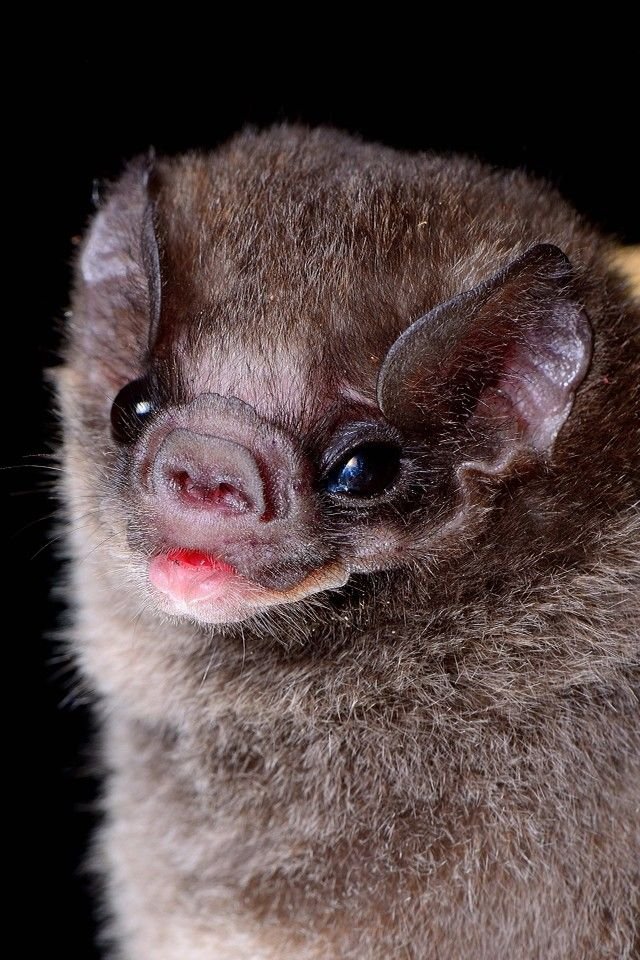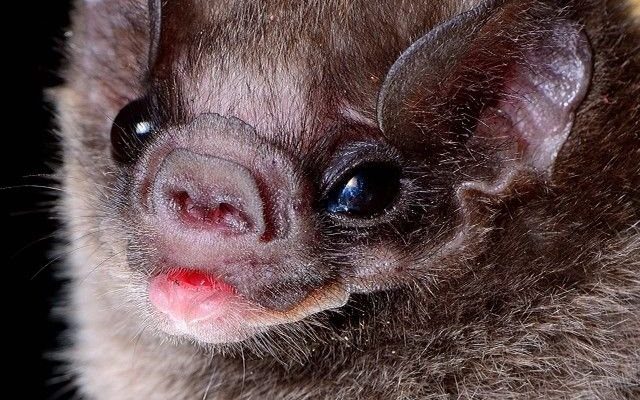
1. Common Vampire Bat
The common vampire bat is the original inspiration behind the tales of bloodsucking bats. Native to Central and South America, this little creature is about 3 inches long and has a wingspan of about 7 inches. What sets it apart? Well, it has specialized heat sensors on its nose that help it locate blood vessels on warm-blooded animals, allowing it to feed.
While many folks might picture them hanging upside down in dark caves, they actually tend to roost in abandoned buildings or hollow trees. Here’s the thing: They don’t just suck blood; they make small incisions in their prey’s skin and lap it up like a drink. It’s almost like having a tiny vampire bartender at the ready!
Distinguishing Features
– Size: About 3 inches long.
– Diet: Exclusively feeds on blood, primarily from livestock.
– Social Behavior: Often seen in groups, exhibiting interesting social dynamics.
2. Hairy-Legged Vampire Bat
Next up is the hairy-legged vampire bat—sounds a bit Halloween-y, right? This bat is a close relative of the common vampire bat, but it stands out due to its furry legs. Unlike its more streamlined counterpart, the hairy-legged vampire bat is a bit bulkier.
These bats are also primarily found in Central and South America but are less common. Their penchant for hanging out in tree hollows gives them a distinct habitat preference. If you happen to spot one, you’ll notice its darker fur and larger ears, which help it hear better while hunting.
Key Differences
– Fur: Noticeably hairier legs compared to the common vampire bat.
– Habitat: Prefers tree hollows rather than buildings.
– Size: Slightly larger than the common vampire bat.
3. Fruit Bats
Fruit bats, also known as flying foxes, might seem worlds apart from vampire bats, but they share some family ties. These gentle giants are primarily fruit eaters and play a crucial role in pollination and seed dispersal. Their large wings and sweet faces make them quite endearing, don’t you think?
While they don’t suck blood, their affinity for fruit means they can gather in massive numbers, sometimes darkening the sky. What’s interesting is that their social structure is quite complex. They groom each other and engage in playful antics high above the trees.
How to Spot a Fruit Bat
– Diet: Feeds on fruits, nectar, and pollen.
– Size: Can have a wingspan up to 6 feet!
– Ears and Muzzle: Often larger and more elongated than vampire bats.
4. Pipistrelles
Pipistrelles are tiny, widespread bats found all over Europe and parts of Asia. Unlike vampire bats, they are insectivorous, meaning they primarily feast on moths and beetles. They may not have the dramatic bloodsucking reputation, but these bats have fascinating echolocation abilities.
When you think about it, they’re like little aerial acrobats, swooping through the night sky. If you ever catch a glimpse of them flitting around, you might think they’re just miniature black shadows darting about. Pretty cool, right?
Identifiable Traits
– Diet: Eats a variety of insects.
– Size: Very small, about 3–4 inches in length.
– Echolocation: Highly skilled at navigating in the dark.
5. Greater Mouse-eared Bat
This bat has a name that sounds like it belongs in a fairy tale, but it’s quite real! The greater mouse-eared bat is another insect-eating champ, often found in Europe and parts of Asia. What makes this bat stand out? Its large ears help it hear even the faintest sounds, guiding it to its insect prey.
While it doesn’t share the same bloodsucking diet as our vampire friends, its rounded ears and fluffy appearance give it a cute, cuddly vibe. Imagine a bat that could fit in the palm of your hand, with big ears flopping as it zooms around!
Spotting Differences
– Diet: Insects, including moths and flies.
– Ears: Larger and rounder compared to vampire bats.
– Habitat: Often roosts in caves, attics, or hollow trees.
6. Red Bat
The red bat is a striking little creature with its beautiful reddish fur. While it doesn’t suck blood like the vampire bat, it loves to feast on moths, beetles, and other insects. You might find them roosting in the foliage of trees, blending in quite well with nature’s palette.
Their roosting style is unique; they often hang in a way that resembles a dead leaf. Can you imagine walking by and mistaking them for part of the scenery? Their distinctive coloration makes identification a breeze.
Identifying the Red Bat
– Color: Bright reddish fur.
– Diet: Insects, particularly moths.
– Roosting Behavior: Hangs in leaves, mimicking foliage.
7. Spix’s Macaw
Now, switching gears a bit, Spix’s macaw might not seem similar to vampire bats at all. However, both species are unique in their habitats and adaptations. The Spix’s macaw is critically endangered, just like the rare species of bats found in the same regions of Brazil.
Although they are not genetically related, their plight highlights the importance of habitat preservation. Just like vampire bats that thrive in specific ecosystems, Spix’s macaws’ survival depends on protecting Brazil’s forests. Plus, their vibrant blue feathers make them unforgettable!
Key Characteristics
– Color: Bright blue plumage.
– Diet: Primarily feeds on nuts and fruits.
– Conservation Status: Critically endangered and highly protected.
8. Common Raccoon
Raccoons are often found in North America and have a reputation for being curious and clever. While they are not bats, their nocturnal habits and scavenging behavior make them a fascinating comparison. Have you seen a raccoon digging through trash? They’re a bit like nature’s little detectives!
Raccoons tend to have a diet that includes fruits, plants, insects, and even human leftovers. Despite their reputation for mischief, they play a significant role in their ecosystem—just like vampire bats do by controlling insect populations with their feeding habits.
How to Tell Them Apart
– Diet: Omnivorous; eats almost anything.
– Habitat: Often found in urban areas near water sources.
– Behavior: Highly intelligent and social.
9. Barn Owl
The barn owl might not seem like it belongs on this list, but its hunting style can be compared to that of vampire bats. These owls are silent hunters, gliding through the night in search of small mammals. They have extraordinary hearing, which helps them pinpoint prey in complete darkness.
Being an expert at hunting, they often take on the role of pest controllers, just like vampire bats do with insects. Their heart-shaped face and striking colors make them stand out against the night sky, creating an enchanting sight for anyone lucky enough to see one.
Identifying Features
– Hunting Method: Silent flight and excellent hearing.
– Diet: Primarily small mammals and rodents.
– Habitat: Favors open fields, often nesting in barns.
10. The Naked Mole Rat
Last but not least, let’s talk about the naked mole rat. Although it seems quite a stretch from the vampire bat, this underground dweller shares some unique characteristics. Naked mole rats live in colonies similar to vampire bats’ social structures. They have a highly developed social order, with one queen and many workers, much like a bee colony.
While they don’t fly or suck blood, their unusual appearance and fascinating behaviors make them memorable. Plus, they’re often called one of nature’s oddities, which is a fun connection back to the vampire bat!
Spotting a Naked Mole Rat
– Appearance: Hairless, wrinkled skin with large teeth.
– Diet: Primarily roots and tubers.
– Social Behavior: Live in colonies with a strict hierarchy.
In conclusion, the animal kingdom is full of surprises. From the bloodsucking vampire bat to the quirky naked mole rat, creatures share fascinating traits and adaptations. While these animals might be different in many ways, they each play a vital role in their ecosystems. Exploring these unique beings not only expands our understanding of nature, but also reminds us of the importance of conservation. So, the next time you hear about the vampire bat or one of its similar friends, you’ll know just how special they all are!

